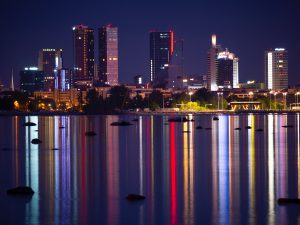63 Europe: Urban Geography II – Tallinn, Estonia
“If geography is prose, maps are iconography.”
– Lennart Meri – the second president of Estonia, 1992-2001

Photo by Julius Jansson on Unsplash
Tallinn is the capital city of Estonia, a small Baltic country with a striking historical mix in recent decades of communism followed by capitalism and Russia/USSR followed by independence. Tallinn itself displays a remarkable contrast between its well-preserved Old Town and its modern European city center.
Anthropologically, we know that settlement in this strategic coastal location in Northern Europe began before 3000 BC; however, historical reference to a named town did not occur until 1219 BCE. Until the 20th century, the town and eventually the city was known as Reval, originally a Danish-language place name reflecting Danish territorial control.
When Estonia became independent in 1918 (for the years between world wars), the city was re-named Tallinn, an Estonian language reference to its fortified walls, as –linnais a suffix meaning castle or fortification.
The medieval fortifications began in the 10th or 11th century on the city’s limestone plateau (or hill) known as Toompea. Early on, these fortifications provided shelter and defense as needed, but were not used for habitation. The structures that now define Tallinn’s Old Town mainly were built originally in the 15th and 16th centuries.

Reval (again, the early name for Tallinn) was primarily under Danish control from 1219 forward one century. In the late 13th century, Reval joined the profitable and influential Hanseatic Trading League (Hansa meaning fleet), where Estonian trade peaked in the prosperous 15th century. However, Denmark sold some of its northern European lands, including Reval, to the German Order (also known as the Teutonic Knights). This brought German influence and culture to Reval.
The Livonian War of 1558-1583 brought Russian, Swedish, and Polish interests into the region. In the early part of the war in 1561, Tallinn sided with Sweden. This allegiance remained true until 1710. During the Livonian War, those buildings inside the fortification remained intact, while many structures outside the wall and in the lower town were destroyed. Although saved from war, much inside the protection of the upper town walls was ruined by the Great Fire of 1684.
The Northern War of 1700-1721 again brought Russian forces to Reval, as the city capitulated in 1710. Under tsarist rule initially by Peter the Great, the city developed industrially and renewed its harbor’s role in trade. In 1870 rail service between Reval and St. Petersburg was established, increasing Reval’s economic links with the Russian Empire.
World War I and the Bolshevik Revolution signaled the end of the empire’s hold on Reval and the region. Brief intra-war German presence passed with the German failure to win the war. In the post-war diplomatic arrangements, Estonia became an independent country. One of the first steps of independence was the change of the capital city’s name from Reval to Tallinn. During the years of Soviet rule after World War II, Estonians viewed this interwar independence as a golden age. By 1939 the population of Tallinn reached 145 thousand, amidst avid days of Estonian cultural expression.
In the secret protocol attached to the Molotov-Rippentrop Pact (non-aggression pact between the Soviet Union and Nazi Germany), the Baltic States were placed within the Soviet sphere of influence. This set up the Soviet annexation of Estonia, Latvia, and Lithuania in 1940. However, in 1941 the Nazis attacked the USSR anyway and in August of that year they occupied Tallinn. Eventually in September 1944, Soviet forces regained the city. While there was war damage to Tallinn, most of the Old Town remained intact.
During Soviet days, Tallinn benefitted from the close ethnic links between Finns and Estonians. Their Finno-Ugric language family, shared with Hungarian and scattered small ethnic groups like Sami peoples, brings the ability to understand both languages. Easy transport from Helsinki, Finland, to Tallinn brought exposure to Western culture, as did Finnish TV broadcasts, understood and received in Tallinn. The Baltic States were at the forefront of the movement to end the Soviet Union and to create multiple new independent countries. Through the Singing Revolution (non-violent opposition to Soviet rule and censorship), Estonians propelled this drive for independence and attained it in 1991.

Since gained sovereignty, Estonia and Tallinn as its capital city and focal point have pushed freedom, liberty, democracy, and capitalism forward quickly and forcefully. Tallinn is visited by over four million tourists yearly. The medieval setting of the Old Town, city walls, stone towers, and cobblestone streets is a delight for visitors and has earned UNESCO’s designation as a World Heritage City.
Even so, Tallinn has modernized quickly, adding skyscrapers and technology. The modern Tallinn is a global city that features e-commerce and digital lifestyles. Check this video for a quick look —https://www.youtube.com/watch?time_continue=1&v=w8OmvV7d5yI

Overall, Tallinn is a remarkable city, blending historical and cultural influences from varied centuries and effects of Danish, German, Russian, Soviet control mixed with two stretches of independence, plus shared linguistic and ethnic roots with Finns. Tallinn’s population now is about 434 thousand, ethnically mixed with 51% Estonian and 36% Russian.
Did You Know?
It would have been highly fitting if World Chess Champion (1960-61) Mikhail Tal had been from Tallinn, but actually he was born in Riga, the capital of neighboring Latvia.
According to Estonian lore, the structures built on Toompea cover the burial site of the Estonian (and Finnish) mythical hero Kalev. In Star Trek lore, Kahless is a messianic figure in Klingon history. Probably unrelated!
For a bonus look at Estonia, try the quiz and news at https://www.nytimes.com/interactive/2018/01/29/learning/29EstoniaGeographyQuizLN.html. You should get the urban quiz question correct, at least.
In the second season of “Star Trek: Picard,” actress Orla Brady plays a character named “Tallinn.” The actress is Irish, not Estonian.
Hot Off the Press
Cited and additional bibliography:
Franganillo, Jorge. 2019. Tallinn Town Square. https://tinyurl.com/tallinntownsquare. Attribution 2.0 Generic (CC BY 2.0).
“History of Tallinn.” n.d. Www.Tallinn.Ee. Accessed June 2, 2020. https://www.tallinn.ee/eng/History-of-Tallinn.

